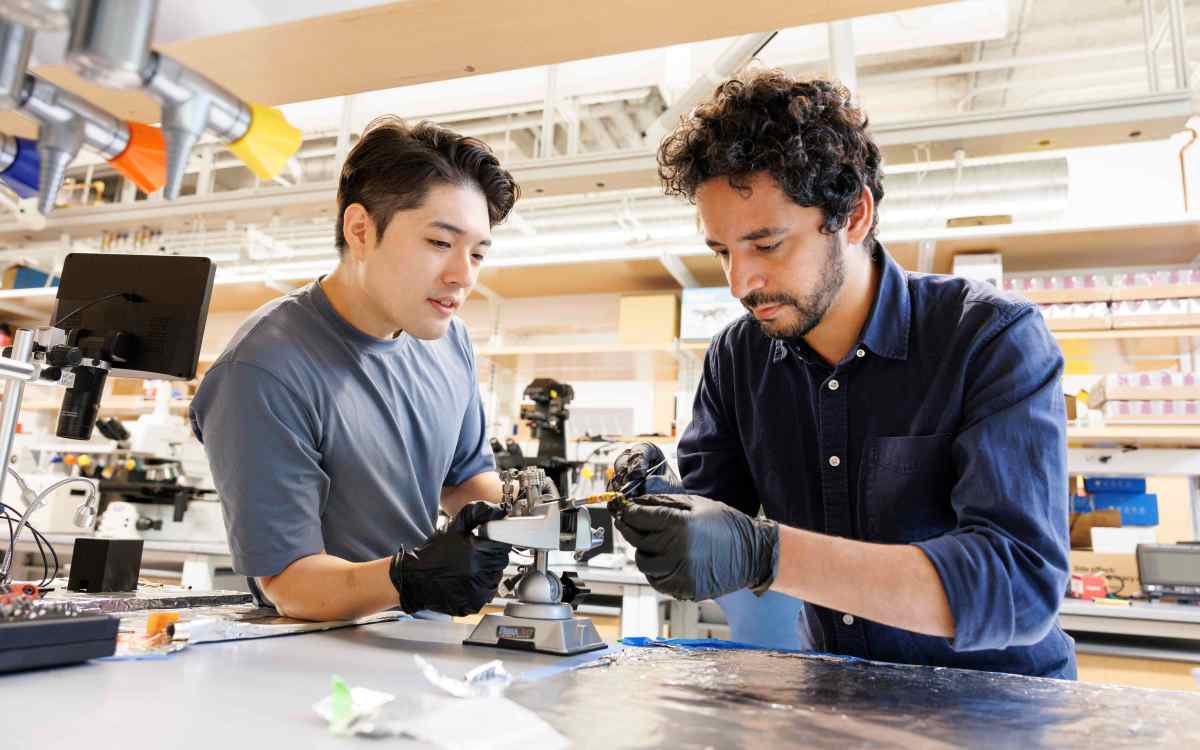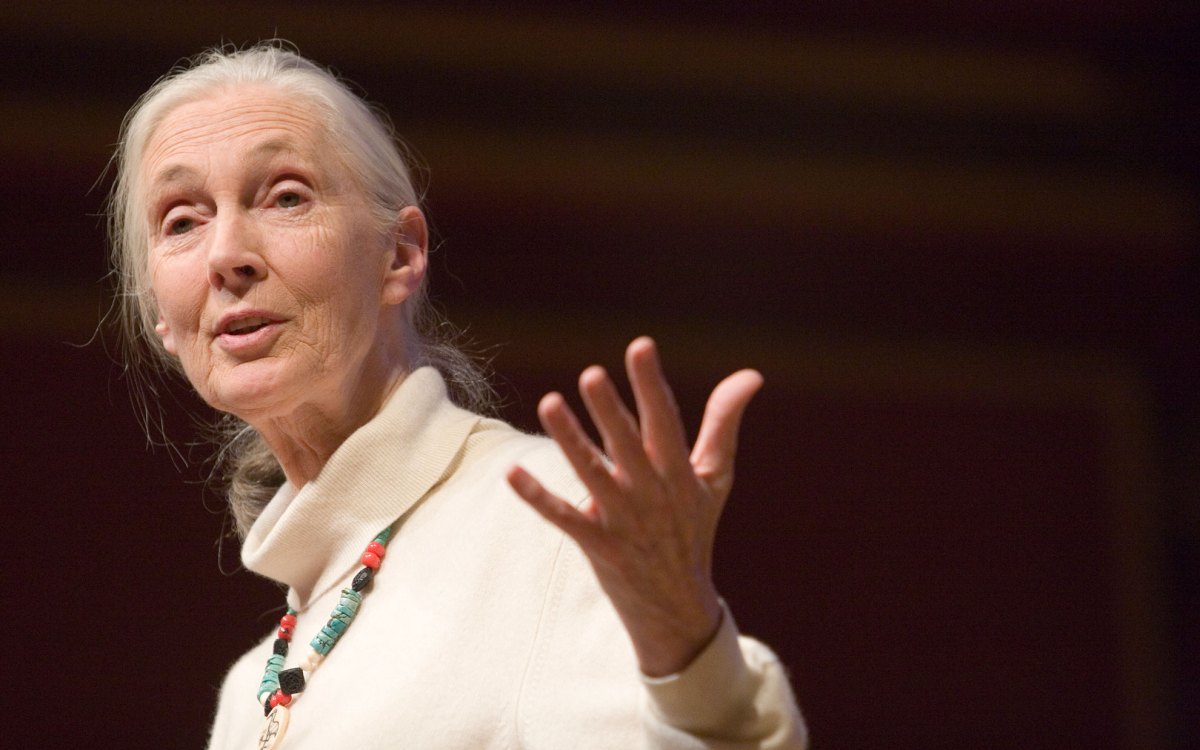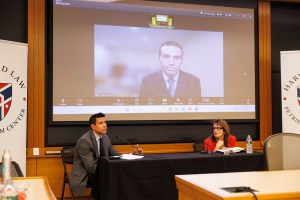Science & Tech
-

Harsh past might bare its teeth
Early adversity leads to higher aggression and fearfulness in adult canines, study says

-

What will AI mean for humanity?
Scholars from range of disciplines see red flags, possibilities ahead
-

‘Human exceptionalism is at the root of the ecological crisis’
Saving the planet requires getting over ourselves, argues author of ‘The Arrogant Ape’
-

Lauren Williams awarded MacArthur ‘genius grant’
Math professor honored for theoretical breakthroughs with sometimes surprising applications across phenomena such as tsunamis, traffic
-

-

‘She had a sense of caring for everybody that she encountered.’
Richard Wrangham remembers his teacher and colleague Jane Goodall as a force of science, empathy, and hope
-
Cosmic blast announces a future supernova
It’s one thing to theorize about an exploding star the size of our sun, it’s another to look up in the sky and watch one getting ready to blow. Astronomers…
-
Jupiter’s ‘big brother’ has moon-forming dust disk
Earth’s moon was created by an early collision with another large planetary body. It was a “chip off the old block.” Mars captured its asteroidal moons as they passed by.…
-
Under-diagnosed rage disorder more prevalent than previously thought
A seldom-studied mental illness called Intermittent Explosive Disorder, characterized by recurrent episodes of angry and potentially violent outbursts — seen in cases of road rage or spousal abuse — has…
-
Tamed 11,400 years ago, figs likely first domesticated crop
Archaeobotanists have found evidence that the dawn of agriculture may have come with the domestication of fig trees in the Near East some 11,400 years ago, roughly 1,000 years before…
-
‘Virginity pledges’ by adolescents may bias their reports of premarital sex
Adolescents who sign a “virginity pledge” and then go on to have premarital sex are likely to disavow having signed such a pledge, according to an analysis of survey data…
-
Obesity levels in U.S. states are grossly underestimated
The prevalence of obesity in the U.S. states has been greatly underestimated. Researchers at the Harvard School of Public Health analyzed data from health surveys, which are used to estimate…
-
Discovery of calcium channel protein illuminates T cell signaling
A rare genetic defect in a family has helped researchers identify a key signaling component in T cells. The newly identified protein, Orai1, may be a piece of a long-…
-
Solitons may be the next wave in electronic circuits
Harvard scientists have solved the puzzle of how to generate a special form of wave in small electronic devices, allowing the electrical equivalent of the pulses of light that carry…
-
Newly found species fills evolutionary gap between fish and land animals
Paleontologists have discovered fossils of a species that provides the missing evolutionary link between fish and the first animals that walked out of water onto land about 375 million years…
-
Study finds M-rated video games contain violence, sexual themes, substances, and profanity not labeled on game boxes
According to a study led by Associate Professor Kimberly Thompson of the Kids Risk Project at Harvard School of Public Health, 81 percent of a random sample of “mature”-rated video…
-
Researchers create pigs that produce omega-3 fatty acids
Researchers report they have created pigs that produce omega -3 fatty acids, which are known to improve heart function and help reduce the risks for heart disease, representing the first…
-
Child enrichment program still pays off after 15 years
Researchers have detected the lasting benefits of early childhood education 15 years after the program ended. What may have seemed like three years of fun and games at the time…
-
Global warming yields ‘glacial earthquakes’ in polar areas
Seismologists at Harvard University and Columbia University have found an unexpected offshoot of global warming: “glacial earthquakes” in which Manhattan-sized glaciers lurch unexpectedly, yielding temblors up to magnitude 5.1 on…
-
Blogging from the Ugandan forest
A Web log, or blog, co-written by Harvard researcher Ian Gilby, working in Uganda’s Kibale Forest, makes vivid the family lives of chimpanzees. The blog, on the Anthropology Department Web…
-
Super-Earths may be three times more common than Jupiters
Astronomers have discovered a new “super-Earth” orbiting a red dwarf star located about 9,000 light-years away. This newfound world weighs about 13 times the mass of the Earth and is…
-
Mold, mold everywhere
Mold has attacked what remains of New Orleans, engulfing the city in slime. Typically, clean indoor environments show mold spore concentrations of less than 1,000 per cubic meter of air.…
-
Two teams address Harvard planning and development
To meet the increased physical planning and development needs of the faculties and departments on Harvard’s existing campus while simultaneously preparing for first-phase development in Allston, the Harvard Planning + Allston Initiative (HPAI) – the team that coordinated University-wide physical planning – has been reconfigured into two University organizations.
-
Brigham pilot program connects people with family histories
A Harvard Medical School instructor at Brigham and Women’s Hospital is spearheading a pilot project to encourage Brigham employees to gather detailed family health histories to give health care officials an edge fighting inherited diseases.
-
The first word on nouns and verbs
Since humans learned to speak, they have put their words into two basic categories, nouns and verbs. Nouns denote objects; verbs refer to actions. Dictionaries of specialized words have been added by bankers, lawyers, scientists, and clergy, but this core distinction remains.
-
Controlling long-term memory
Harvard University biologists have identified a molecular pathway active in neurons that interacts with RNA to regulate the formation of long-term memory in fruit flies. The same pathway is also found at mammalian synapses, and could eventually present a target for new therapeutics to treat human memory loss.
-
Gift from Jordans advances FAS, health research
The Faculty of Arts and Sciences (FAS) and disease-fighting researchers across Harvard are the recipients of Jerry and Darlene Jordan’s recent $10 million gift to the University. The gift is just the latest expression of the Jordans’ generosity: Over the years, Jerry ’61, M.B.A. ’67, and Darlene Jordan have funded financial aid, athletics, and other programs at Harvard College and the Business School.Five million dollars of their gift is designated for the Faculty of Arts and Sciences to help strengthen FAS programs, as well as enrich student life at the College.
-
Sidanius named professor of African American Studies
James H. Sidanius, a psychologist best known for establishing and refining an influential theory of social dominance along lines of gender, age, race, and class, has been named professor of psychology and of African and African American Studies in Harvard University’s Faculty of Arts and Sciences, effective Jan. 1.
-
Neutron star swaps lead to short gamma-ray bursts
Gamma-ray bursts are the most powerful explosions in the universe, emitting huge amounts of high-energy radiation. For decades their origin was a mystery. Scientists now believe they understand the processes…
-
Two exiled stars are leaving our galaxy forever
TV reality show contestants aren’t the only ones under threat of exile. Astronomers using the MMT Observatory in Arizona have discovered two stars exiled from the Milky Way galaxy. Those…
-
Berkman Center helps launch StopBadware campaign
The problems caused by badware have very serious implications, both for every day use of computers, and for the long-term viability of the open Internet. On Jan. 25, 2006, the…
-
Cosmic jet looks like giant tornado in space
While examining a region where new stars are forming with NASA’s Spitzer Space Telescope, astronomers found a surprise – an object that looks like a giant tornado in space. The…
-
There’s more to the North Star than meets the eye
We tend to think of the North Star, Polaris, as a steady, solitary point of light that guided sailors in ages past. But there is more to the North Star…
-
Harvard studies Katrina survivors
A new project, funded by a $1 million grant from the National Institute of Mental Health, will recruit Katrina survivors around the country to serve on the Hurricane Katrina Community…
-
Ancient humans brought bottle gourds to Americas from Asia
Thick-skinned bottle gourds widely used as containers by prehistoric peoples were likely brought to the Americas some 10,000 years ago by individuals who arrived from Asia, according to a new…
-
Report documents importance of playlists
Drawing from an early-adopter survey conducted through Gartner, Harvard College student Derek Slater and Mike McGuire, Gartner research director, found that consumer-to-consumer recommendation tools, like playlists, enable consumers to actively…


